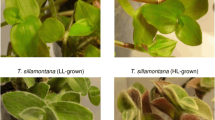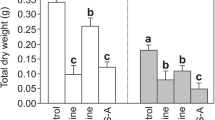Abstract
The function of photosystem (PS)II during desiccation and exposure to high photon flux density (PFD) was investigated via analysis of chlorophyll fluorescence in the desert resurrection plant Selaginella lepidophylla (Hook. and Grev.) Spring. Exposure of hydrated, physiologically competent stems to 2000 μmol · m−2 · s−1 PFD caused significant reductions in both intrinsic fluorescence yield (FO) and photochemical efficiency of PSII (FV/FM) but recovery to pre-exposure values was rapid under low PFD. Desiccation under low PFD also affected fluorescence characteristics. Both FV/FM and photochemical fluorescence quenching remained high until about 40% relative water content and both then decreased rapidly as plants approached 0% relative water content. In contrast, the maximum fluorescence yield (FM) decreased and non-photochemical fluorescence quenching increased early during desiccation. In plants dried at high PFD, the decrease in FV/FM was accentuated and FO was reduced, however, fluorescence characteristics returned to near pre-exposure values after 24-h of rehydration and recovery at low PFD. Pretreatment of stems with dithiothreitol, an inhibitor of zeaxanthin synthesis, accelerated the decline in FV/FM and significantly increased FO relative to controls at 925 μmol · m−2 · s−1 PFD, and the differences persisted over a 3-h low-PFD recovery period. Pretreatment with dithiothreitol also significantly decreased non-photochemical fluorescence quenching, increased the reduction state of QA, the primary electron acceptor of PSII, and prevented the synthesis of zeaxanthin relative to controls when stems were exposed to PFDs in excess of 250 μmol · m−2 · s−1. These results indicate that a zeaxanthin-associated mechanism of photoprotection exists in this desert pteridophyte that may help to prevent photoinhibitory damage in the fully hydrated state and which may play an additional role in protecting PSII as thylakoid membranes undergo water loss.
Similar content being viewed by others
Abbreviations
- DTT:
-
dithiothreitol
- EPS:
-
epoxidation state
- FO :
-
yield of instantaneous fluorescence at open PSII centers
- FM :
-
maximum yield of fluorescence at closed PSII centers induced by saturating light
- FM :
-
FM determined during actinic illumination
- FV :
-
yield of variable fluorescence (FM-FO)
- FV/FM :
-
photochemical efficiency of PSII
- qP :
-
photochemical fluorescence quenching
- qNP :
-
non-photochemical fluorescence quenching of Schreiber et al. (1986)
- NPQ:
-
non-photochemical fluorescence quenching from the Stern-Volmer equation
- PFD:
-
photon flux density
- RWC:
-
relative water content
References
Adams, W.W. III, Smith, S.D., Osmond, C.B. (1987) Photoinhibition of the CAM succulent Opuntia basilaris growing in Death Valley: evidence from 77 K fluorescence and quantum yield. Oecologia 71, 221–228
Adams, W.W. III, Diaz, M., Winter, K. (1989) Diurnal changes in photochemical efficiency, the reduction state of Q, radiationless energy dissipation, and nonphotochemical fluorescence quenching in cacti exposed to natural sunlight in northern Venezuela. Oecologia 80, 553–561
Anderson, J.M. (1986) Photoregulation of the composition, function, and structure of thylakoid membranes. Annu. Rev. Plant. Physiol. 37, 93–136
Bilger, W., Björkman, O. (1990) Role of the xanthophyll cycle in photoprotection elucidated by measurements of light-induced absorbance changes, fluorescence and photosynthesis in leaves of Hedera canariensis. Photosyn. Res. 25, 173–186
Bilger, W., Björkman, O. (1991) Temperature dependence of violaxanthin de-epoxidation and non-photochemical fluorescence quenching in intact leaves of Gossypium hirsutum L. and Malva parviflora L. Planta 184, 226–234
Bilger, W., Björkman, O., Thayer, S.S. (1989a) Light-induced spectral absorbance changes in relation to photosynthesis and the epoxidation state of xanthophyll cycle components in cotton leaves. Plant Physiol. 91, 542–551
Bilger, W., Rinke, S., Schreiber, U., Lange, O.L. (1989b) Inhibition of energy-transfer to photosystem II in lichens by dehydration; different properties of reversibility with green and blue-green phycobionts. J. Plant Physiol. 134, 261–268
Björkman, O., Demmig, B. (1987) Photon yield of O2 evolution and chlorophyll fluorescence characteristics at 77 K among vascular plant of diverse origin. Planta 170, 489–504
Casper, C. (1992) Photoprotection and photodamage in Selaginella lepidophylla and Ulva rotundata under light and water stress. M.S. Thesis, Freie Universität, Berlin, Germany
Demmig, B., Winter, K., Krüger, A., Czygan, F.-C. (1987) Photoinhibition and zeaxanthin formation in intact leaves: a possible role of the xanthophyll cycle in the dissipation of excess light energy. Plant Physiol. 84, 218–224
Demmig, B., Winter, K., Krüger, A., Czygan, F.-C. (1988) Zeaxanthin and the heat dissipation of excess light energy in Nerium oleander exposed to a combination of high light and water stress. Plant Physiol. 87, 17–24
Demmig-Adams, B. (1990) Carotenoids and photoprotection in plants: a role for the xanthophyll zeaxanthin. Biochim. Biophys. Acta 1020, 1–24
Demmig-Adams, B., Adams, W.W. III (1990) The carotenoid zeaxanthin and high-energy-state quenching of chlorophyll fluorescence. Photosyn. Res. 25, 187–198
Demmig-Adams, B., Winter, K., Krüger, A., Czygan, F.-C. (1989) Light response to CO2 assimilation, dissipation of excess energy, and zeaxanthin content of sun and shade leaves. Plant Physiol. 90, 881–886
Demmig-Adams, B., Adams, W.W. III, Czygan, F.-C., Schreiber, U., Lange, O.L. (1990a) Differences in the capacity for radiationless energy dissipation in the photochemical apparatus of green and blue-green algal lichens associated with differences in carotenoid composition. Planta 180, 582–589
Demmig-Adams, B., Adams, W.W. III, Heber, U., Neimanis, S., Winter, K., Krüger, A., Czygan, F.-C., Bilger, W., Björkman, O. (1990b) Inhibition of zeaxanthin formation and of rapid changes in radiationless energy dissipation by dithiothreitol in spinach leaves and chloroplasts. Plant Physiol. 92, 293–301
Demmig-Adams, B., Máguas, C., Adams, W.W. III, Meyer, A., Kilian, E., Lange, O.L. (1990c) Effect of high light on the efficiency of photochemical energy conversion in a variety of lichen species with green and blue-green phycobionts. Planta 180, 400–409
Eickmeier, W.G. (1979) Photosynthetic recovery in the resurrection plant Selaginella lepidophylla after wetting. Oecologia 39, 93–106
Eickmeier, W.G., Lebkuecher, J.G., Osmond, C.B. (1992) Photosynthetic water oxidation and water stress in plants. In: Water and life: comparative analysis of water relationships at the organismic, cellular and molecular levels, pp. 223–239, Somero, G.N., Osmond, C.B., Bolis, C.L., eds. Springer, Berlin Heidelberg New York
Foyer, C., Furbank, R., Harbinson, J., Horton, P. (1990) The mechanisms contributing to photosynthetic control of electron transport by carbon assimilation in leaves. Photosyn. Res. 25, 83–100
Gilmore, A.M., Yamamoto, H.Y. (1991) Zeaxanthin formation and energy-dependent fluorescence quenching in pea chloroplasts under artificially mediated linear and cyclic electron transport. Plant Physiol. 96, 635–643
Horton, P., Ruban, A.V., Rees, D., Pascal, A.A., Noctor, G., Young, A.J. (1991) Control of the light-harvesting function of chloroplast membranes by aggregation of the LHCII chlorophyll-protein complex. FEBS Lett. 292, 1–4
Krause, G.H. (1988) Photoinhibition of photosynthesis. An evaluation of damaging and protective mechanisms. Physiol. Plant. 74, 566–574
Krause, G.H., Weis, E. (1991) Chlorophyll fluorescence and photosynthesis: the basics. Annu. Rev. Plant Physiol. Plant Mol. Biol. 42, 313–349
Lange, O.L., Bilger, W., Rinke, S., Schreiber, U. (1989) Chlorophyll fluorescence of lichens containing green and blue-green algae during hadration by water vapor and by addition of liquid water. Bot. Acta 102, 306–313
Larson, R.A. (1988) The antioxidants of higher plants. Phytochemistry 27, 969–978
Lebkuecher, J.G., Eickmeier, W.G. (1991) Reduced photoinhibition with stem curling in the resurrection plant Selaginella lepidophylla. Oecologia 88, 597–604
Lebkuecher, J.G., Eickmeier, W.G. (1992a) Photoinhibition of photophosphorylation, adenosine triphosphate content, and glyceraldehyde-3-phosphate dehydrogenase (NADP+) following high-irradiance desiccation of Selaginella lepidophylla. Can. J. Bot. 70, 205–211
Lebkuecher, J.G., Eickmeier, W.G. (1992b) Physiological benefits of stem curling in the resurrection plant Selaginella lepidophylla in the field. Ecology, in press
Öquist, G., Fork, D.C. (1982) Effects of desiccation on the excitation energy distribution from phycoerythrin to the two photosystems in the red alga Porphyra perforata. Physiol. Plant. 56, 56–62
Powles, S. (1984) Photoinhibition of photosynthesis induced by visible light. Annu. Rev. Plant Physiol. 35, 15–44
Powles, S.B., Osmond, C.B., Thorne, S.W. (1979) Photoinhibition of intact attached leaves of C3 plants illuminated in the absence of both carbon dioxide and of photorespiration. Plant Physiol. 64, 982–988
Schreiber, U., Schliwa, U., Bilger, W. (1986) Continuous recording of photochemical and nonphotochemical chlorophyll fluorescence quenching with a new type of modulation fluorometer. Photosyn. Res. 10, 51–62
Schwab, K.B., Schreiber, U., Heber, U. (1989) Response of photosynthesis and respiration of resurrection plants to desiccation and rehydration. Planta 177, 217–227
Thayer, S.S., Björkman, O. (1990) Leaf xanthophyll content and composition in sun and shade determined by HPLC. Photosyn. Res. 23, 331–343
Weis, E., Berry, J. (1987) Quantum efficiency of photosystem II in relation to energy dependent quenching of chlorophyll fluorescence. Biochim. Biophys. Acta 894, 198–208
Winter, K., Königer, M. (1989) Dithiothreitol, an inhibitor of violaxanthin de-epoxidation, increases the susceptibility of leaves of Nerium oleander L. to photoinhibition of photosynthesis. Planta 180, 24–31
Winter, K., Lesch, M., Diaz, M. (1990) Changes in xanthophyllcycle components and in fluorescence yield in leaves of a crassulacean-acid-metabolism plant, Clusia rosea Jacq., throughout a 12-h photoperiod of constant irradiance. Planta 182, 181–185
Yamamoto, H.Y., Kamite, L. (1972) The effects of dithiothreitol on violaxanthin de-epoxidation and absorbance change in the 500-nm region. Biochim. Biophys. Acta 267, 538–543
Author information
Authors and Affiliations
Additional information
This paper is based on research done while W.G.E. was on leave of absence at Duke University during the fall of 1990. We would like to thank Dan Yakir, John Skillman, Steve Grace, and Suchandra Balachandran and many others at Duke University for their help and input with this research. Dr. Barbara Demmig-Adams provided zeaxanthin for standard-curve purposes.
Rights and permissions
About this article
Cite this article
Eickmeier, W.G., Casper, C. & Osmond, C.B. Chlorophyll fluorescence in the resurrection plant Selaginella lepidophylla (Hook. & Grev.) Spring during high-light and desiccation stress, and evidence for zeaxanthin-associated photoprotection. Planta 189, 30–38 (1993). https://doi.org/10.1007/BF00201340
Accepted:
Issue Date:
DOI: https://doi.org/10.1007/BF00201340




